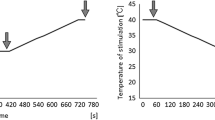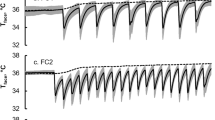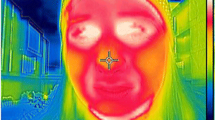Abstract
One purpose of this study was to characterize the facial skin temperature and cold-induced vasodilation (CIVD) response of 12 subjects (six males and six females) during exposure to cold wind (i.e., −10 to 10°C; 2, 5, and 8 m/s wind speed). This study found that at each wind speed, facial skin temperature decreased as ambient temperature decreased. The percentage of subjects showing facial CIVD decreased significantly at an ambient temperature above −10°C. A similar CIVD percentage was observed between 0°C dry and 10°C wet (face sprayed with fine water mist) at each wind speed. No CIVDs were observed during the 10°C dry condition at any wind speed. The incidence of CIVD response was more uniform across facial sites when there was a greater cold stress (i.e., −10°C and 8 m/s wind). Another objective of the study was to examine the effect of the thermal state of the body (as reflected by core temperature) on the facial skin temperature response during rest and exercise. This study found that nose skin temperature was significantly higher in exercising subjects with an elevated core temperature even though there was no significant difference in face skin temperature between the two conditions. Therefore, this finding suggests that acral regions of the face, such as the nose, are more sensitive to changes in the thermal state of the body, and hence will stay warmer relative to other parts of the face during exercise in the cold.










Similar content being viewed by others
References
Bergersen TK (1993) A search for arteriovenous anastomoses in human skin using ultrasound Doppler. Acta Physiol Scand 147(2):195–201
Brahdy L (1935) Frostbites among employees of the city of New York. JAMA pp 529–532
Brajkovic D and Ducharme MB (2001). Maintaining finger dexterity in the cold: a comparison of passive, direct and indirect hand heating methods. In: NATO human factors and medicine panel symposium on blowing hot and cold: protecting against climatic extremes, Dresden, Germany, October 8–10 proceedings RTO-MP-076 AC/323 (HFM-061) TP/40, p 20
Brajkovic D, Ducharme MB (2003) Finger dexterity, skin temperature, and blood flow during auxiliary heating in the cold. J Appl Physiol 95:758–770
Brajkovic D, Ducharme MB, Frim J (1998) Influence of localized auxiliary heating on hand comfort during cold exposure. J Appl Physiol 85(6):2054–2065
Brajkovic D, Ducharme MB, Frim J (2001) Relationship between body heat content and finger temperature during cold exposure. J Appl Physiol 90(6):2445–2452
Daanen HA (2003) Finger cold-induced vasodilation: a review. Eur J Appl Physiol 89(5):411–426
Daanen HA, Ducharme MB (1999) Finger cold-induced vasodilation during mild hypothermia, hyperthermia and at thermoneutrality. Aviat Space Environ Med 70(12):1206–1210
Daanen HA, Ducharme MB (2000) Axon reflexes in human cold exposed fingers. Eur J Appl Physiol 81(3):240–244
Daanen HA, Van de Linde FJ, Romet TT, Ducharme MB (1997) The effect of body temperature on the hunting response of the middle finger skin temperature. Eur J Appl Physiol Occup Physiol 76(6):538–543
Danielsson U (1996) Windchill and the risk of tissue freezing. J Appl Physiol 81(6):2666–2673
DuBois D, DuBois EF (1916) A formula to estimate the approximate surface area if height and weight be known. Arch Inter Med 17:863–871
Forsyth RD, Plyley MJ, Shephard RJ (1984) Estimation of body fatness of Canadian Forces. Can J Appl Sport Sci 9(4):5
Fox RH, Wyatt HT (1962) Cold-induced vasodilatation in various areas of the body surface of man. J Physiol 162:289–297
Gavhed D, Makinen T, Holmer I, Rintamaki H (2000) Face temperature and cardiorespiratory responses to wind in thermoneutral and cool subjects exposed to −10°C. Eur J Appl Physiol 83(4–5):449–456
Goldman RF (1980) Protection against cold injury. Contemp Orthop 2(3):263–266
Hirai K, Horvath SM, Weinstein V (1970) Differences in the vascular hunting reaction between Caucasians and Japanese. Angiology 21(8):502–510
Hollies NRS, Goldman RF (1977) Psychological scaling in comfort assessment. Clothing comfort: interaction of thermal, ventilation, construction, and assessment factors. Ann Arbor Science Publishers Inc., Ann Arbor, pp 107–120
LeBlanc J (1954) Subcutaneous fat and skin temperature. Can J Biochem Physiol 32:354–358
LeBlanc J, Blais B, Barabe B, Cote J (1976) Effects of temperature and wind on facial temperature, heart rate, and sensation. J Appl Physiol 40(2):127–131
Lehmuskallio E (2000) Emollients in the prevention of frostbite. Int J Circumpolar Health 59(2):122–130
Lewis T (1930) Observations upon the reactions of the vessels of the human skin to cold. Heart 15:177–208
Makinen T, Gavhed D, Holmer I, Rintamaki H (2000) Thermal responses to cold wind of thermoneutral and cooled subjects. Eur J Appl Physiol 81(5):397–402
Makinen TT, Gavhed D, Holmer I, Rintamaki H (2001) Effects of metabolic rate on thermal responses at different air velocities in −10°C. Comp Biochem Physiol A Mol Integr Physiol 128(4):759–768
Rapaport SI, Fetcher ES, Shaub HG, Hall JF (1949) Control of blood flow to the extremities at low ambient temperatures. J Appl Physiol 2:61–71
Rintamaki H, Hassi J, Oksa J, Makinen T (1992) Rewarming of feet by lower and upper body exercise. Eur J Appl Physiol Occup Physiol 65(5):427–432
Seals DR, Victor RG (1991) Regulation of muscle sympathetic nerve activity during exercise in humans. Exer Sport Sci Rev 19:313–349
Sinks T, Mathias T, Halperin W, Timbrook C, Newman S (1987) Survaillance of work-related cold injuries using workers’ compensation claims. J Occup Med 26(6):504–509
Siple PA, Passel CF (1945) Measurements of dry atmospheric cooling in subfreezing temperatures. Proc Am Philos Soc 89(1):177–199
Steegmann AT (1967) Frostbite of the human face as a selective force. Human Biol 39(2):131–144
Steegmann AT (1972) Cold response, body form, and craniofacial shape in two racial groups of Hawaii. Am J Phys Anthrop 37:193–222
Steegmann AT Jr (1979) Human facial temperatures in natural and laboratory cold. Aviat Space Environ Med 50(3):227–232
Virokannas H, Anttonen H (1994) Thermal responses in the body during snowmobile driving. Arctic Med Res 53(Suppl 3):12–18
Wilson O, Goldman RF (1970) Role of air temperature and wind in the time necessary for a finger to freeze. J Appl Physiol 29(5):658–664
Wyndham CH, Wilson-Dickson WG (1951) Physiological responses of hands and feet to cold in relation to body temperature. J Appl Physiol 4:199–207
Acknowledgements
We acknowledge the technical support of Robert Limmer and Debbie Kerrigan-Brown.
Author information
Authors and Affiliations
Corresponding author
Rights and permissions
About this article
Cite this article
Brajkovic, D., Ducharme, M.B. Facial cold-induced vasodilation and skin temperature during exposure to cold wind. Eur J Appl Physiol 96, 711–721 (2006). https://doi.org/10.1007/s00421-005-0115-3
Accepted:
Published:
Issue Date:
DOI: https://doi.org/10.1007/s00421-005-0115-3




